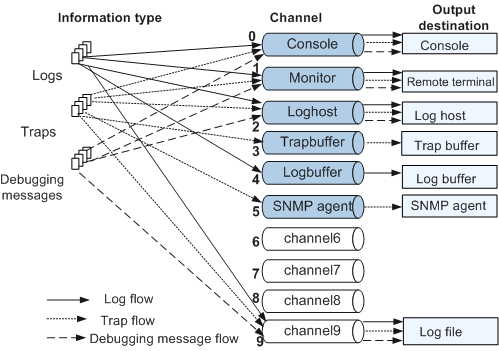Information Output
Information generated by the device can be output to a remote terminal, console, log buffer, log file, or SNMP agent. To output information in different directions, 10 information channels are defined for the information center. These channels work independently from one another. You can configure output rules so that information is output through different channels in different directions based on information type and severity level. An example is shown in Figure 1.
By default, logs, traps, and debugging messages are output through default channels. You can change names of the channels as well as the relationships between channels and output directions as required. For example, you can set the name of channel 6 to user1 and configure channel 6 to send information to the log host. The information sent to the log host is then output through channel 6 instead of the default channel 2.
Table 1 lists channel numbers, default channels of information, and descriptions.
Channel Number |
Default Channel Name |
Output Direction |
Description |
|---|---|---|---|
0 |
console |
Console |
Outputs logs, traps, and debugging messages to the local console. |
1 |
monitor |
Remote terminal |
Outputs logs, traps, and debugging messages to a VTY terminal for remote maintenance. |
2 |
loghost |
Log host |
Outputs logs, debugging messages, and traps. The information is saved to the log host in file format for easy reference. |
3 |
trapbuffer |
Trap buffer |
Outputs traps. |
4 |
logbuffer |
Log buffer |
Outputs logs. |
5 |
snmpagent |
SNMP agent |
Outputs traps. |
6 |
channel6 |
Unspecified |
Reserved. You can specify an output destination for this channel. |
7 |
channel7 |
Unspecified |
Reserved. You can specify an output destination for this channel. |
8 |
channel8 |
Unspecified |
Reserved. You can specify an output destination for this channel. |
9 |
channel9 |
Logfile |
Outputs logs, debugging messages, and traps. |
